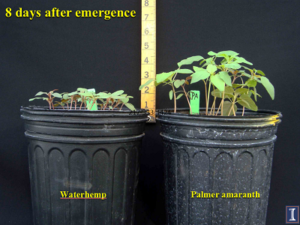Emi Kimura, State Extension Peanut Specialist, Vernon, TX
Josh McGinty, Extension Agronomist at Corpus Christi, TX
James Grichar, Senior Research Scientist at Yoakum, TX
Pete Dotray, Weed Scientist at Lubbock, TX
Best Management Practices (BMPs) for peanut production include effective season-long weed management. Below are four weed management principles in peanut production.
- Start clean
- Use residual herbicides
- Timely postemergence applications
- Know your weeds
In the April article, we discussed the importance of preplant burndown (PP), preplant incorporated (PPI), and preemergence (PRE) herbicide applications for reducing early-season weed competition and maximize yield and profitability of peanut production. In May, peanut acres are slowly getting planted across the state. Growers will soon start seeing some weeds escaping from residual herbicides applied prior to or at planting. Early season weed control is essential for reducing competition for water, nutrients, and light between the peanut plant and weeds. In addition, the soil seed bank will drastically be reduced by controlling weeds before they make seed with timely applications of postemergence (POST) herbicides. It is time to plan for EPOST (10-20 days after planting or DAP) and POST (30-45 DAP) herbicide applications.
Table 1. Timing of herbicide application in peanut
| PP | PPI | PRE | EPOST
10-20 DAP |
POST
30-45 DAP |
*DAP: Days after planting
When applying EPOST and POST herbicides, the following factors must be considered.
- Always apply EPOST and POST herbicides when soil moisture conditions are good!
Weeds must be actively growing to absorb and translocate the herbicide for maximum efficacy. When herbicides are applied to weeds growing under stressed conditions (drought, high temperatures, disease or insect damage), reduced efficacy is often observed.
- Coverage is a key for improved weed control!
Always use enough spray volume to achieve good coverage for improved weed control. Often, weed control failures after the application of POST herbicides are due to low spray volumes and insufficient spray coverage.
- Always use appropriate adjuvants!
Adjuvants such as non-ionic surfactants (NIS) and crop oil concentrates (COC) reduce the surface tension of the spray solution and help dissolve or soften cuticular waxes on the leaf, improving uptake of the herbicide. Additionally, many product labels recommend the addition of ammonium sulfate or urea ammonium nitrate to improve efficacy. Always check the product label to see what adjuvants to include. Please refer to the April article written by Dr. Bell and others for more detail on adjuvants.
Herbicide options for EPOST and POST applications
There are several herbicides labeled for EPOST and POST use in peanut. Imazapic (e.g., Cadre and other generics) and imazethapyr (e.g., Pursuit and other generics) can control many broadleaf (2- to 4-inches depending on weed species) and grass weeds (smaller than 1.5 inches), and nutsedge (yellow and purple); however, please pay attention to the long crop rotation restriction to cotton and sorghum (18 months) and wheat (4 months). In addition, there are increasing weed populations that are resistant or tolerant to imazapic and imazethapyr across the peanut belt. The use of herbicides with different modes of action is key to delay/prevent the development of herbicide-resistant weed biotypes.
Bentazon (e.g., Basagran and other generics), acifluorfen (e.g., UltraBlazer and other generics), bentazon + acifluorgen (e.g., Storm), and lactofen (e.g., Cobra and other generics) are options for EPOST and POST herbicide applications. Bentazon has activity on common purslane, cocklebur, sunflowers, and yellow nutsedge. Acifluorfen and lactofen are effective at controlling Palmer amaranth, annual morningglory, smellmelon, carpetweed and other broadleaf weeds. Activity from these herbicides will quickly decrease as weed size increases beyond 4 inches. Waterhemp and Palmer amaranth can reach this height as quickly as 8-10 days after emergence (photo 1). Frequent scouting is very important to make prompt decisions on EPOST and POST applications.
Photo 1. Growth of waterhemp and Palmer amaranth 8 days after emergence (Photo credit: University of Illinois).
Storm includes two active ingredients (bentazon + acifluorfen) for controlling a wide range of small and actively growing annual broadleaf weeds. For grass weed control, use clethodim (e.g, Select and other generics), sethoxydim (e.g., Poast and other generics), and fluazifop-P-butyl (e.g., Fusilade).
S-metolachlor (e.g., Dual Magnum and other generics) and dimethenamid (e.g., Outlook and other generics) are PRE herbicides that may also be used EPOST to provide extended residual weed control. These herbicides will only control weeds that germinate after application and will not have activity on emerged weeds. Please read the labels for incorporation methods. If S-metolachlor and dimethenamid are tank mixed with other POST herbicide such as bentazon, irrigation must be delayed 4-6 hours to allow uptake of the POST herbicide.
Pyroxasulfone (Zidua SC and Zidua WG) is labeled for use in peanut from ground-crack to pegging. Pyroxasulfone is effective on a number of annual grass and broadleaf weeds but does not control emerged weeds.
Texas Peanut Variety website at http://varietytesting.tamu.edu/peanuts/


